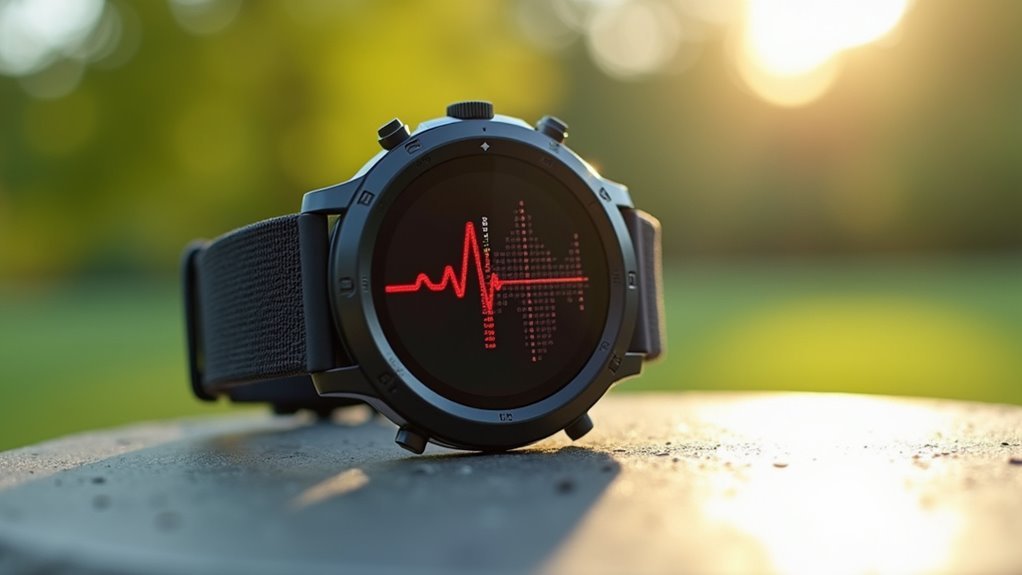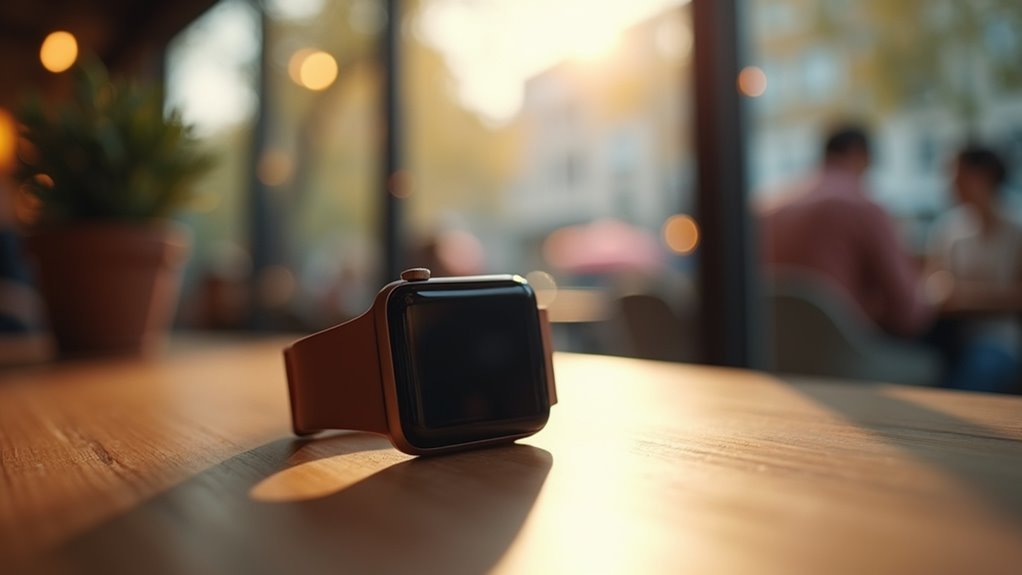You’ll find the best stress monitoring in sport watches like the Apple Watch Ultra 2 with thorough health features, Samsung Galaxy Watches using advanced AI algorithms, and Garmin models offering built-in stress scores through physiological analysis. Budget-conscious athletes can choose the Fitbit Charge 5 for $150 with EDA tracking and ECG, or the Inspire 3 at $100. These devices use real-time heart rate variability sensors and integrate seamlessly with apps like Welltory for extensive stress insights that optimize your training performance.
Best Smart Watches With Advanced Stress Tracking Technology
As stress becomes an increasingly prevalent health concern in our fast-paced world, smartwatches have emerged as powerful tools that leverage artificial intelligence to monitor and manage your stress levels in real-time.
These devices use sophisticated sensors to track heart rate variability (HRV), blood oxygen saturation, and ECG patterns that indicate stress responses.
The Apple Watch Ultra 2 leads with extensive health features and rugged design, while Google’s Pixel Watch 3 excels in Android integration. All smartwatches undergo extensive testing by health and fitness experts to ensure accurate stress monitoring capabilities.
For budget-conscious users, the Fitvii 2025 GT5 PRO MAX offers ECG and stress monitoring at an affordable price.
Samsung Galaxy Watches utilize advanced AI algorithms to provide personalized insights, and the GTS 7 Pro delivers competitive HRV monitoring.
These watches continuously analyze your data, converting complex physiological signals into actionable stress management recommendations.
Essential Health Monitoring Features for Athletic Performance
While stress monitoring provides valuable insights into your mental wellbeing, sport watches offer a detailed suite of health tracking capabilities that can dramatically enhance your athletic performance and safety.
Sport watches deliver comprehensive health tracking that transforms both your athletic performance and personal safety through advanced monitoring capabilities.
You’ll benefit from real-time heart rate monitoring and ECG functionality that detects dangerous arrhythmias, essential since nearly 1 in 50,000 young athletes experience cardiac arrest annually. Advanced sensors track your oxygen saturation, respiratory rate, and body temperature to optimize training intensity and prevent overheating.
Motion tracking through IMUs analyzes your technique and movement patterns, while pressure sensors in compatible gear assess force distribution to prevent injuries. EMG sensors monitor muscle fatigue and activation, helping you avoid overuse injuries.
These extensive metrics enable personalized training adjustments, workload management, and early warning alerts for potential health risks. The data collected can contribute to industry knowledge sharing platforms where athletes and professionals exchange insights about performance optimization.
Budget-Friendly Options for Comprehensive Stress Analysis

Though premium sport watches often command prices exceeding $500, you can access extensive stress monitoring capabilities for under $300 with several excellent budget-friendly options.
The Fitbit Charge 5 ($150) delivers advanced EDA tracking and ECG functionality, while the Inspire 3 ($100) provides solid stress, sleep, and heart rate monitoring.
Garmin’s Vivosmart 5 offers thorough stress analysis at a similar price point, and the Vivoactive 5 delivers up to 11 days of battery life with advanced stress features.
You’ll find these devices excel at continuous heart rate monitoring and daily stress scoring.
However, consider Garmin’s paywall-free approach versus Fitbit’s premium subscriptions when choosing.
Most budget models sacrifice some display size and advanced sports features but maintain reliable stress tracking accuracy that rivals premium alternatives. These trackers provide user-friendly interfaces that make accessing your stress data and health metrics simple and straightforward.
App Integration and Compatibility Across Popular Platforms
Beyond the device itself, your sport watch’s stress monitoring capabilities depend heavily on how well it integrates with your existing apps and digital ecosystem. Apps like Welltory connect seamlessly with Samsung, Garmin, Fitbit, Polar, and Mi Band devices while syncing with Google Fit, Samsung Health, and Huawei Health platforms.
| Platform | Key Apps | Integration Features |
|---|---|---|
| Apple Watch | Breathe, Stress Monitor | HRV tracking, native iOS sync |
| Wear OS | Welltory, Google Fit | Multi-device compatibility, real-time updates |
| Garmin | Built-in stress score | Physiological analysis, actionable feedback |
You’ll benefit from cross-platform data aggregation that combines heart rate, HRV, and activity metrics. Third-party integrations with productivity apps like RescueTime and meditation platforms create thorough stress management workflows across your smartphone and wearable devices. The most effective stress monitoring apps process your heart data continuously throughout the day rather than providing only sporadic readings during workouts.
Battery Performance and Durability for Continuous Monitoring

Continuous stress monitoring demands robust battery performance that won’t leave you scrambling for a charger mid-workout or during extended monitoring periods.
Reliable battery life ensures your stress tracking never misses a beat during crucial monitoring moments.
The Amazfit Balance and Garmin smartwatches lead with 14-day battery life, perfect for uninterrupted stress tracking. Fitbit offers seven days, while Moto Watch 120 provides ten days with rapid charging capabilities.
Apple Watch’s 18-hour battery requires daily charging, potentially disrupting continuous monitoring.
Durability matters equally for active users. Amazfit Balance features stainless steel construction, while Garmin and Fitbit utilize reinforced bodies with scratch-resistant glass. The Balance also incorporates anti-glare glass bezel for enhanced visibility during outdoor activities and bright conditions.
Most sport watches include water resistance and shock protection for high-impact activities.
Power management features like adaptive sensor activation and power-saving modes help optimize battery life without compromising data continuity during your stress monitoring sessions.
Frequently Asked Questions
How Accurate Are Sport Watch Stress Readings Compared to Medical Devices?
You’ll find sport watch stress readings are less accurate than medical devices because they use PPG sensors instead of medical-grade ECG technology and lack clinical validation standards.
Can Stress Monitoring Work Effectively During High-Intensity Workouts?
You’ll find stress monitoring works during high-intensity workouts, though accuracy decreases. Your watch can track heart rate variability and cortisol indicators, but extreme movements and sweat may affect sensor readings and data reliability.
Do These Watches Provide Personalized Stress Management Recommendations?
You’ll receive personalized stress management recommendations based on your heart rate variability, sleep patterns, and activity data. These watches offer tailored breathing exercises, meditation sessions, and lifestyle adjustments specific to your stress triggers.
How Do Environmental Factors Like Altitude Affect Stress Monitoring Accuracy?
Altitude affects your stress monitoring accuracy by altering heart rate variability, reducing blood oxygen levels, and shifting physiological baselines. You’ll need device recalibration and careful data interpretation for reliable readings.
Can Multiple Users Share One Watch for Family Stress Tracking?
You can’t effectively share one sports watch for family stress tracking. Each user needs their own device since watches don’t support multiple users, and shared accounts compromise personalized data accuracy and privacy.
In Summary
You’ll find that investing in a quality stress monitoring sport watch transforms your training approach and overall wellness management. Whether you’re choosing a premium model with cutting-edge sensors or a budget-friendly option with essential features, you’re taking control of your health data. Don’t overlook app compatibility and battery life—they’ll determine how effectively you can track patterns and maintain consistent monitoring throughout your active lifestyle.





Leave a Reply